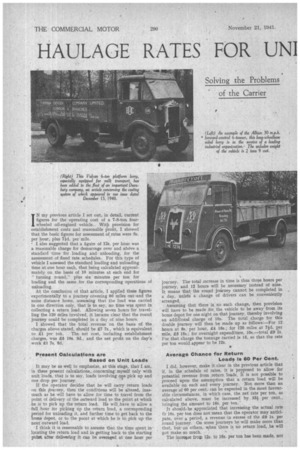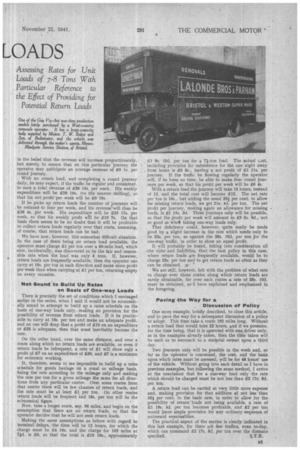HAULAGE RATES FOR UN! LOADS
Page 20

Page 21

If you've noticed an error in this article please click here to report it so we can fix it.
Solving the Problems of the Carrier
iN my previous article I set out, in detail, current figures for the operating cost of a 7-8-ton fourwheeled oil-engined vehicle.. With provision for establishment costs and reasonable Profit. I showed that the basic figures for assessment of rates were 8s. per hour, plus Thd. per mile. I "also suggested that a figure of 12s. per hour was a reasonable charge for demurrage over and above a standard time for loading and unloading, for the assessment of -fixed rate schedules. For this type of vehicle I assessed the standard loading and unloading time at -one hour each, that being calculated approximately on the basis of 10 minutes at each end for " turning round," plim six minutes per ton for loading and the same for the corresponding operations of
unloading. .
At the conclusion of that article, I applied these figures experimentally to a journey covering 60 miles out and the same distance home, assuming that the load was carried in one direction only, that is to say, no time was spent in collecting a return load. Allowing seven hours for travelling the 120 miles involved, it became clear that the round journey could be completed _in a day of nine hours.
I showed that the total revenue on the basis of the charges above stated, should be 27 7s., which is equivalent to 21 per toh. The net cost, including establishment charges, was £5 19s. 3d., and the net profit on the day's work 21 7s. 9d.
Present Calculations are Based on Unit Loads
It may be as well to emphasize, at this stage, that I am, in these present calculations„ concerning'..myself only with
unit loads, that is to say, loads involving one pick up and • • one drop per journey.
If the operator decides that he will carry return loads on this lbw ney, then the conditions will be altered, inasmuch as he will have to allow for time to travel from the point of delivery of the outward load to the point at which he is to pick up the return load. He will ,have to allow a • full hour for picking tip the return load, a corresponding periodfor unloading it, and further time to get back to the home depot, or to the point at which he is to pick up the next outward load.
• I think it is reasonable to assume that the time spent in. locating the return load and in getting back to the starting point after delivering it can be averaged at one hour per journey. The total increase in time is thus three hours per journey, and 12 hours will be necessary' insteadof nine. It means that the round journey cannot be completed in a day, unle§s a change of drivers can be conveniently arranged. Assuming that there is,. no such change, then provision will have to be made .for, the vehicle to be away from its home depot for one night on that journey, thereby involving an additional charge of 10s. The total charge for this double journey will then be made up as follows:—For 12 hours at 8s. per hour, 24 16s.; for 120 miles at 71d. per mile, 23 15s.; for overnight expenditure, 10s.—total £9 is. For that charge the tonnage carried is 15, so that the rate per ton would appear to be 12s.
Average Chance for Return Load, Is 60 Per Cent.
I did, however, make it clear in the previous article that if, in the schedule of rates, it is proposed to allow for potential revenue from return loads, It is not possible to proceed upon the assumption that a return load will be available on each and every journey. Not more than an average of 60 per cent. can be expected in the most favourable circumstances, in which case, the net rate per ton, as calculated above, must be increased by 33i per cent., bringing the amount to 16s. per ton." It should$1)e appreciated that increasing the actual rate fa 16s. per ton does not mean that the operator may anticipate, over a period, a revenue in excess of the £9 Is. per round journey. On some journeys he will make more than that, but on others, vi/hen there is no return load, ,he will .not make so much.
The incise from 12s. to 16s, per ton has been made, not
in the belief that the revenue will increase proportionately, but merely to ensure that on this particular journey the operatoi. may anticipate an average revenue of £9 Is. per round journey.
With no return load, and completing a round journey daily, he may expect, if the traffic be regular and consistent, to earn a total revenue of £36 15s, per week. His weekly expenditure will be £29 16s, (to the nearest shilling), so that his net profit'per week will be £6 19s.
If he picks up return loads the number of journeys will be reduced to four per week, and his revenue will thus be £36 4s. per week. His expenditure will be £25 17s. per week, so that his weakly profit wlll be £10 7s. On that basis there seems to be no doubt that it will be profitable to collect return loads regularly over that route, assuming, of course, that return loads can be had.
We have now, however, this somewhat difficult situation. In the case of there being no return load available, the operator must charge £1 per ton over a 60-mile lead, which -rate, incidentally, was discovered to be the fair and reasonable rate when the load was only 5 tons. If, however, return loads are frequently available, then the operator can carry at 16s. per ton in each direction and make more profit per week than when carrying at £1 per ton, returning empty on every occasion.
Not Sound to Build Up Rates on Basis of One-way Loads There is precisely the set of conditions which I envisaged earlier in the series, when I said it would not be economically sound to attempt to build up a rates schedule on the basis of one-way loads only, making no provision for the possibility of revenue from return loads. If it be practicable to carry at 16s. per ton and make an adequate profit, and no one will deny that a profit of £10 on an expenditure of £25 is adequate, then that must inevitably become the rate.
On the other hand, over the same distance, and over a
route along which no return loads are available, or even if return loads be infrequent, a rate of £1 will show only a profit of £7 on an expenditure of £30, and £7 is a minimum for ecanotnic working.
It, therefore, seems to me impossible to build up a rates schedule for goods haulage on a zonal or mileage basis, fixing the rate according to the mileage only and making the rate per ton for a given mileage the same fcer all directions from any particular centre. Over some routes from that centre there will be few chances of return loads, and the rate must be at least £1 per ton. On other routes return loads will be frequent and 16s. per ton will be the economical figure.
Now, take a longer route, say, 96 miles, and begin on the assumption that there are no return loads, or that the operator decides that he will not seek return loads.
Making the same assumptions as before with regard to terminal delays, the time will be 12 hours, for which the charge must be £4 16s. and the charge for 192 miles at 7id. is £6, so that the total is £10 16s., approximately
£1 8s. 10d, per ton for a 7i-ton load. The actual wet, including provision for subsistence for the one night away ft-0M home is £9 5s., leaving a net profit of 41 1 ls. per journey. If the traffic be flowing regularly the operator will, if he loses no time, be able to make four round journeys per week, so that his profit per week will be 26 4s.
With a return load the journey will take 15 hours, instead of 12, and the total cost will become £12. The net rate per ton is 16s., but adding the usual 33i per cent, to allow for missing return loads, we get 21s. 4d. per ton. The net profit per journey, making again an allowance for missing loads, is £1 I55. 3d. Three journeys only will be possible, so that the Profit per week will amount to £5 5s. 9d., not so good as when taking one-way loads only. That deficiency could, however, quite easily be made good by a slight increase in the rate which needs only to he 22s. per ton, as against the 28s. 10d. per ton for the one-way traffic, in order to show an equal profit. It will probably be found, taking into consideration all the risks and liabilities, that, the best policy in this case, where return loads are frequently available, would be to charge 25s. per ton and to get return loads as often as they can be obtained. e We are still, however, left with the problem of what rate to charge over those routes along which return loads are rarely obtainable, for over such routes a rate of 28s. 10d. must be obtained, as I have explained and emphasized in i he foregoing.
Paving the Way for a , Discussion of' Policy One more example, briefly described, to close this article, and to pave the way for a subsequent discussion of a policy to adopt. This time take a route 192 miles long. Without a return load that would take 22 hours, and if we presume, for the time being, that it is operated with 'one driver only, as in the examples already taken, then the time taken will be such as to encroach to a material extent upon a third day.
Two journeys only will be possible in the week and, so far as the operator is concerned, the cost, and the basis upon which rates must be assessed, will be for 48 hours' use of the vehicle. Without going into such detail as I have in previous examples, but following the same method, I arrive at the conclusion that for a one-way load only the rate which should be charged must be not less than £2 17s. 8d. per ton.
A return load can he carried at very little more expense and, making provision for that addition of not less than 33} per cent. to the basic rate, in order to allow for the possibility of return loads not being available, a rate of £1 18s. 41. per ton becomes profitable, and £2 per ton would leave ample provision for any ordinary sequence of untoward eventualities. The practical aspect of the matter is clearly indicated in this last example, for there are few traffics, even to-day, which can command £2 17s. 8d. per ton over the distance
specified. S.T.R.




















































